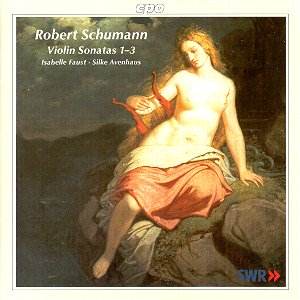Robert SCHUMANN (1810-56)
Violin Sonatas - No. 1 in A minor, Op. 105
No. 2 in D minor, Op. 121
No. 3 in A minor, Op. posth.
 Isabelle Faust (violin); Silke
Avenhaus (piano).
Isabelle Faust (violin); Silke
Avenhaus (piano).
 CPO 999 597-2 [DDD]
[66'38]
CPO 999 597-2 [DDD]
[66'38]
Crotchet

Isabelle Faust is no run-of-the-mill violinist, as her debut disc on Harmonia
Mundi Les Nouvelles Interprètes attested
(HMN911702,
including Bartók's Second Violin Sonata with Florent Boffard). Here
she is joined by the young German pianist Silke Avenhaus. The shadow of Kremer
and Argerich
(DG
419 235-2) looms large over the first two sonatas, but does not overpower
it. Faust and Avenhaus have produced a disc which communicates the essence
of chamber music. They only lack the last ounce of fantasy which would have
guaranteed an unhesitating recommendation.
Ferdinand David, Wilhelm Wasielewski and Joseph Joachim collectively inspired
Schumann's violinistic outpouring. The violin and piano share the honours
in these pieces, and Faust and Avenhaus are lucky enough to enjoy a particularly
close rapport: in the finale of the Second Sonata, Op. 121 they react instantly
and spontaneously to each others' playing. The third movement, which contains
some very sparse writing, is atmospherically realised. The first two sonatas
date from 1851. Faust gives impassioned accounts of both. At all times, Faust
and Avenhaus are fully committed without ever overblowing it: the indication
for the first movement to the first sonata says it all: 'Mit leidenschaftlichen
Ausdruck', and this is just what they deliver. The Third Sonata (1853) was
not published until 1956 (by Schott in London). The Intermezzo and Finale
belong to the so-called 'FAE Sonata' (of which Brahms contributed his famous
Scherzo: Albert Dietrich wrote the first). Faust and Avenhaus are alive to
the contrasts and shadings of this piece: the Scherzo is infectiously jaunty.
Recommended.
Colin Clarke
Performance

Recording


